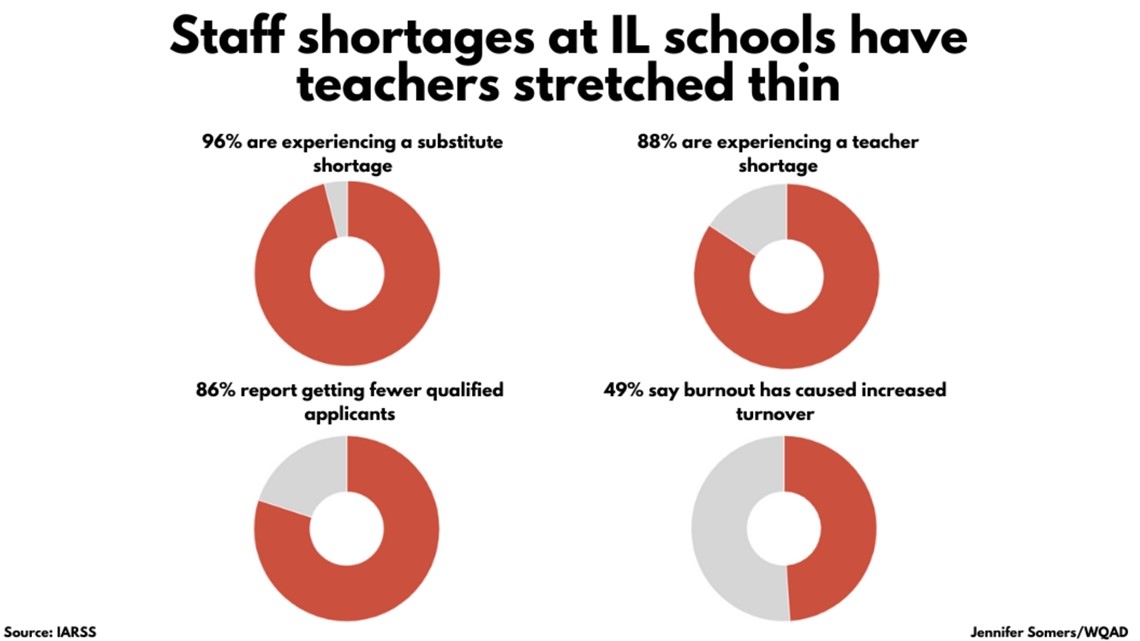SPRINGFIELD, Ill. — EDITOR'S NOTE: The above video originally aired Sept. 22, 2021, on WQAD.
Illinois public schools reported 4,120 unfilled positions for the 2021 school year, a majority of which were in teaching roles, according to the State Board of Education.
Although the number of unfilled positions at the schools has decreased slightly from 2020 (4,462 positions unfilled), the number of unfilled teaching positions has followed an upward trend over the last five years and has more than doubled since 2017.
A recent Illinois Association of Regional Superintendents of Schools survey of 78% of Illinois districts found that the educator shortage is worse than ever before due to factors like the switch back from remote learning to in-person classes, teacher turnover and fewer qualified job applicants.


The COVID-19 pandemic has caused some school boards to approve additional positions to help address the mental toll and learning loss students have experienced. However, many of the new and old positions have remained open.
“Many of the positions that are unfilled this year were unfilled last year," a west-central Illinois superintendent said in the survey. "Last year, we were able to manage because we followed a hybrid model. This year, with students in full time, we have had to use uncertified staff as long-term subs to fill open classroom positions."
The survey found the following jobs were most often unfilled or were filled with a less-than-qualified candidate:
At elementary schools:
- Special education teacher.
- General education teacher.
- Speech and language pathologist.
- School social worker.
- School psychologist.
At middle schools:
- Special education teacher.
- Science teacher.
- English/Language arts teacher.
- Mathematics teacher.
- Speech and language pathologist.
At high schools:
- Special education teacher.
- Mathematics teacher.
- Foreign language teacher.
- Science teacher.
- Business/computer applications teacher.
Teacher shortages
Out of the 663 school districts the IARSS surveyed, 88% said they are experiencing an educator shortage problem.
For jobs left open, districts have responded frequently by making people take on responsibilities beyond their job description, increasing class sizes, outsourcing to third-party vendors, utilizing long-term substitutes, canceling classes, sending classes online and acquiring provisional or emergency certification for staff to fill the roles.
“People are burnt out," an east central Illinois superintendent said. "This is not sustainable.”
Stress, health concerns as well as unwillingness to comply with mask and vaccine-or-test requirements have all contributed to teacher turnover or early retirement in some districts.
“The fatigue of our educators is, across the board, a real concern," a southeast Illinois superintendent said. "In many ways, the level of stress that they have endured is similar to that of trauma.”
In a school year where teachers have been asked to help students recover from the pandemic, teachers nationwide have said they are dealing with overwhelming stress just trying to keep their classes running.
"There are health issues and risks associated with COVID-19, but the mental health issues, the stress and the learning loss caused by COVID-19 have far out-weighed any direct physical health issues that our students have encountered,” a southeast Illinois superintendent said.
Substitute shortages
The survey found 96% of districts have a substitute teacher shortage problem, and 95% believed it will remain a problem in the 2023 and 2024 school years.
Districts have most often dealt with their sub shortage in the following ways:
- Utilizing an existing teacher during their prep time.
- Requiring administrators to teach.
- Hiring full-time subs.
- Redistributing students.
- Providing incentives.
Districts claimed on the survey that obstacles such as the 180-day working limit on retirees and reinstatement penalty for a lapsed certificate have made finding substitutes more difficult.
Some have found success
Not all districts are feeling the statewide shortage equally. The survey found geographic location, salary and benefits, pension, community atmosphere and district resources - all things that disproportionally impact rural, lower-income districts - had the potential to negatively impact job recruitment.
Some districts, though, credit strong administration and creativity with their ability to effectively recruit qualified applicants. According to the survey, some Illinois districts have found success with creative advertising, hiring full-time subs, offering onboarding incentives and partnering with colleges to garner certified applicants.
“We have been very active in helping college graduates become certified through alternative certification program," a northeast Illinois superintendent said. "We have advertised in creative ways. We have established many community partnerships to attract staff as well as made a concerted effort to treat staff well."
In the Quad Cities area, the Moline-Coal Valley School District voted Monday, Jan. 10 to approve its own substitute teacher incentives, including a $300 bonus each time a sub teaches a total of 20, 40, 60 and 80 days for a combined total of up to $1,200.
School districts across the state may need to follow suit with innovative incentives and advertising in order to overcome the difficulties they've faced with retention in classrooms over the years that have only been made worse by the pandemic.

